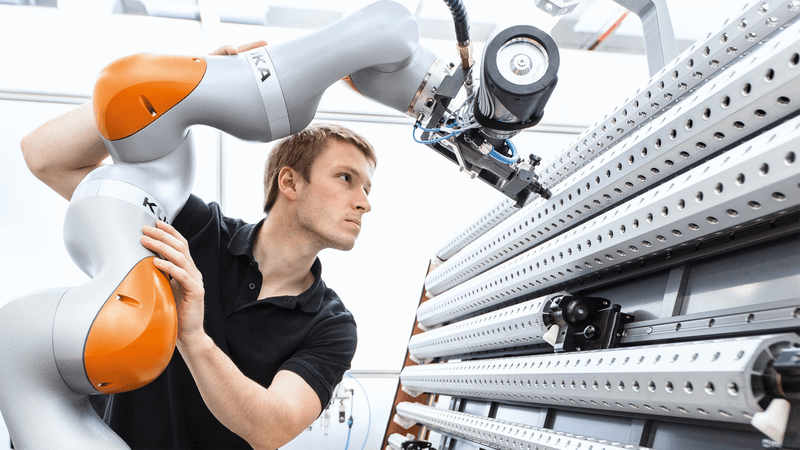
Client:KUKA
Industry:Manufacturing
Region:Europe
Physical Robots Meet Software Robots: KUKA AG Optimizes More than 50 Internal Processes by Using RPA

>50
processes automated with UiPath's RPA technology
18 work days
saved with the help of an RPA bot on data migration during the upgrade from SAP R/3 to SAP S/4HANA
95%
of the internal spare parts orders automated for robots
Client Overview
The KUKA AG's headquarters are located in the Bavarian town of Augsburg. The company has approximately 14,000 employees worldwide. As one of the leading global providers for intelligent automation solutions, KUKA offers a one-stop-shop solution to its customers: ranging from robots to cells and up to fully automated facilities and their integration into the automotive, electronics, general industry, consumer goods, e-commerce/retail and healthcare markets.
To optimize its internal processes and to reduce manual, routine tasks for its employees, KUKA, the globally operating provider of intelligent automation solutions, has used UiPath's RPA solutions to automate more than 50 software processes in its departments up to today. In this way, KUKA provides an example of how to pave the way to an automated future with software robotics in addition to physical robots.
The focus of the process automation is on data exchange in the enterprise resource planning (ERP) and customer relation management (CRM) systems. RPA robots also provide valuable services for efficient data migration during a system change.
Painting, spot welding, adhesive bonding, measuring, quality check or packaging—KUKA's physical industrial robots automate mechanical repetitive processes. They perform tasks and manufacturing processes which previously required the hands of an employee. The same applies to software robots; they take over repetitive and repeating processes from employees working with applications. The keyword is robotic process automation (RPA).
As automation experts we have been relying on RPA since 2018. Our strategic objective is to drive the optimization of our processes with RPA and reduce the monotonous routine tasks for our employees. Furthermore, we want to increase the value creation rate, improve data quality and availability and use RPA as a temporary short-term solution for the integration of IT systems, if the development of an interface takes longer than expected.
Patrick Zech • Operational Excellence (OpEx), Project Manager PoC, KUKA
The impulse for RPA was given by the Accounting and Customer Service departments. Many employees in these departments still spend a lot of time on manually processing incoming orders or transferring data and figures into documents. The objective was to automate these tedious and resource-consuming processes as quickly, easily and efficiently as possible, without the need to introduce major IT projects, which are often linked to long preparation and development time and therefore waiting time.
RPA proved to be a solution for quickly automating these processes. A close inter-disciplinary cooperation between IT, specialist departments and OpEx - in particular during the initial phase and the realization of the PoC - ensured a rapid and seamless implementation of RPA
Patrick Zech • Operational Excellence (OpEx), Project Manager PoC, KUKA
PoC: selection of UiPath
To find the best possible RPA provider, KUKA conducted a proof of concept (PoC) with the leading providers in 2018. The following factors were important criteria in the selection process: an RPA solution with a high scope of functions, flexibility in automation, a technology which is easy to learn, cost efficiency, interfaces to systems like CRM, ERP or web applications, as well as connectors to databases in order to increase performance. KUKA decided to use the data transfer between the SAP system and Microsoft Excel as scenario for the RPA PoC, which was previously often conducted manually. The software robot's tasks included extracting data from SAP, transferring it into Excel and then extracting it from Excel again.
During the PoC, UiPath particularly convinced us, on the one hand due to its wide range of functions and the existing interfaces to other systems, and on the other hand because the software can be easily learned without a programming background. In this respect, the UiPath Academy can provide relevant knowledge very efficiently. Since the UiPath community is also very large, solutions can easily be found in the forum.
Dr. Stefan Hummrich • Head of IT Automation, KUKA
Center of excellence in IT
After the PoC, all parties involved understood that RPA was not only a new tool, but a radically new way of automation. With its cross-sectional function, the technology helped to improve many processes and also offered enormous potential for cost savings for the departments. Furthermore, taking the learnings from the PoC into consideration, KUKA decided to locate the CoE for RPA centrally within the IT department in the future in order to ensure governance and a direct connection to other IT teams.
Designing APIs to establish a prompt connection to other systems, often proves to be very complex. RPA serves as a temporary solution, an "plaster" so to say, between the systems. We are therefore able to automate processes quickly without changing the existing IT landscape.
Dr. Stefan Hummrich • Head of IT Automation, KUKA
Decentralized key users in the departments are complementing the RPA CoE in the IT department by contributing their process expertise and by making a significant contribution to the identification of suitable RPA cases (“RPA Scouting”). In this way, a motivated key user also launched the first RPA case in KUKA's Customer Service department.
Software robots automated the first process at the physical robot manufacturer.
The first software robot's task was to automate the transfer of internal spare parts orders from the eCommerce system to the ERP system. As this process, and the eCommerce system were being redesigned at KUKA, no classic IT solution in the form of an interface to the ERP system was yet available. An interface was under development but not yet operational. This resulted in a high manual effort for the colleagues.
That is why we decided to use RPA to provide a faster, temporary solution for the transfer period in order to reduce the workload for the employees in the spare parts department, but also for the project realization in the IT department.
Martin Ernst • RPA DevOps Engineer, KUKA
Within a few weeks, they managed to automate 95 percent of these orders with RPA, and at the same time achieve higher data quality by removing potential errors that could occur during the manual transfer. In addition, KUKA integrated further data sources, such as emails with text analysis conducted by RegEx, which were previously only extracted manually.
This enabled us to increase the value added of automation with little effort. The major success of the project was mainly driven by UiPath's flexibility and the fast training of our Key Users.
Martin Ernst • RPA DevOps Engineer, KUKA
KUKA has now completed the automation of around 50 processes by using software robots in different specialist departments such as Controlling, HR, or IT Service. One example is the bot applied in the HR department, which changes the employees' account details or the bots supporting the Controlling department in the creation of reports and monthly statements, by collecting and preparing data and figures from different systems. The company is operating and steering its robots via the UiPath Orchestrator. The bots are running on identical servers in a global bot farm, however, and are separated by task area in order to follow the role concept.
The migration of data during a system change is another important use case for RPA at KUKA. These are often only one-off jobs, but they do, however, deliver a lot of potential, as several (ten)thousands of data sets are to be transferred to the new system. A concrete example is the data migration during the upgrade from SAP R/3 to SAP S/4HANA. KUKA had previously scheduled three employees to work on this for six full working days. The software robot conducted the data migration automatically over the weekend; the IT employees had the weekend off and could complete more important tasks on the other working days.
In order to achieve a stable and useful automation, we are looking into every single detail during the process analysis. The business case template, developed by us, compares the cost savings of the estimated development time and the runtime costs. This delivers a classic ROI calculation and a BEP, which serves as a basis for our decisions.
Dr. Stefan Hummrich • Head of IT Automation, KUKA
Taking the employees on board
Proper communication about RPA is key to successful change management, making sure that all employees are on board. In the beginning, there were some discrepancies between the CoE's perception of RPA and the internal customers' understanding of RPA. It is not surprising that the employees of a leading manufacturer for industrial robots often associate robotic process automation with a physical—i.e. a "real" robot.
One of KUKA's objectives is that employees identify processes in their department, which could be automated. To this end, the company offers numerous training courses to raise awareness of RPA for this bottom-up approach and to learn how to program software robots. They want to empower their employees to help themselves. What also helps is that the fundamentals of bot development are easy to acquire and in this way, understanding and motivation among the employees increases quickly.
KUKA's plans include a stronger integration of machine learning in order to also be able to manage cases with unstructured data. Furthermore, computer vision is one item on the CoE's agenda. KUKA clearly considers AI and machine learning as a natural extension to RPA.
Related case studies
Ready for your own case study?
Speak to our team of knowledgeable experts and learn how you can benefit from agentic automation.





